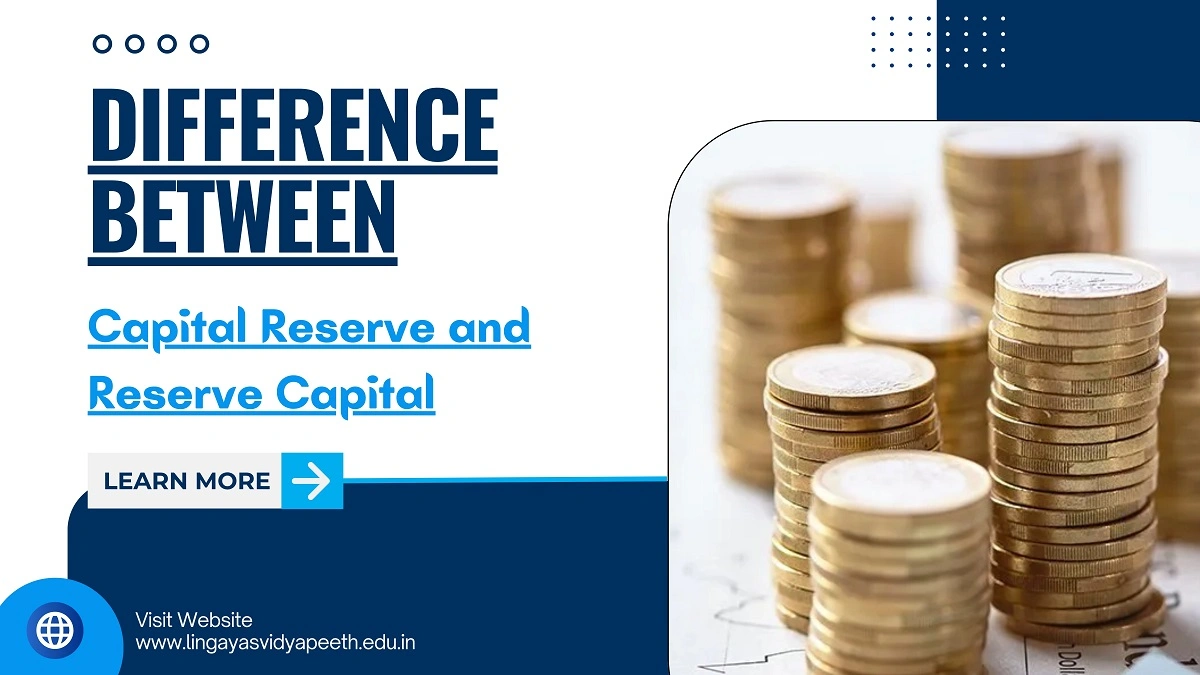Home » Difference Between Capital Reserve and Reserve Capital

Confused by capital reserve and reserve capital? No worries—these accounting terms sound big, but they’re super easy once you break them down. In this blog, we’ll explain the difference between capital reserve and reserve capital, with examples from everyday life, fun facts, and tips on how Lingaya’s Vidyapeeth can help you master these concepts. Whether you’re prepping for exams or curious about commerce, this guide is for you.
A capital reserve is like a piggy bank for a company. It holds money from rare, one-time earnings, not from daily sales. For example, if a company sells an old building or gets a government grant, that cash goes into the capital reserve. This money is saved for big plans, like buying new machines, expanding the business, or paying off loans. Reserve capital isn’t used for daily costs like salaries or bills. It’s saved only for emergencies.
Imagine you run a lemonade stand. One day, you sell your old juicer for ₹3000. That ₹3000 isn’t from selling lemonade—it’s extra cash. You set this money aside to buy a cool new blender in the future.
At Lingaya’s Vidyapeeth, the B.Com Hons and BBA courses teach you how to manage capital reserves like a pro.
Reserve capital is like an emergency fund you don’t touch unless things go really wrong. It’s part of the money shareholders owe the company from shares they’ve bought but haven’t fully paid for. This cash is locked away for extreme situations, like if the company goes bankrupt or needs to pay debts during liquidation.
Think of your piggy bank. You get ₹1000 for your birthday but decide ₹400 is “emergency only” for fixing your bike if it breaks. That ₹400 is like reserve capital—saved for a crisis.
Lingaya’s Vidyapeeth explains reserve capital clearly in its B.Com Hons program, making it easy to understand.
Here’s a clear table to show the difference between capital reserve and reserve capital:
| Point | Capital Reserve | Reserve Capital |
| What It Is | Money from special profits, like selling assets. | Unpaid share money saved for emergencies. |
| Source | From one-time gains, like selling land. | From shareholders’ unpaid share capital. |
| Purpose | For growth or paying loans. | For crises, like bankruptcy. |
| When Used | For specific big plans. | Only in emergencies with approval. |
| Availability | Ready for certain uses. | Locked until a crisis. |
| In Reports | Shows in the balance sheet. | Hidden in regular reports. |
| How It’s Made | From profits or gains. | By a company decision. |
| Dividends | Can’t pay dividends. | Can’t pay dividends either. |
| Flexibility | Easier to use for projects. | Very hard to use. |
| Example | Cash from selling old machines. | Unpaid share money for debts. |
This table makes the difference between capital reserve and reserve capital easy to understand.
Yes, there are a few similarities:
But the difference between capital reserve and reserve capital is much bigger than what they share.
Lingaya’s Vidyapeeth’s B.Com Hons and BBA courses teach you these accounting rules step-by-step.
Understanding these impacts is key, and Lingaya’s Vidyapeeth’s BBA program covers this in detail.
These facts make learning the difference between capital reserve and reserve capital fun.
Dreaming of a career in accounting or business? Lingaya’s Vidyapeeth is the place to start. With Bachelor of Commerce Honours (B.Com Hons) and Bachelor of Business Administration (BBA), you’ll learn:
Lingaya’s Vidyapeeth offers:
Join Lingaya’s Vidyapeeth today and kickstart your commerce journey.
Now you know the difference between capital reserve and reserve capital. Capital reserve is like savings for big dreams, like buying new equipment. Reserve capital is an emergency backup for tough times, like bankruptcy. Both help a company stay strong, but they work in different ways.
Want to learn more? Enrol in Lingaya’s Vidyapeeth’s B.Com Hons or BBA programs. With expert teachers and practical training, you’ll be ready for a bright career in finance or business. Don’t wait—join Lingaya’s Vidyapeeth and shine in the world of commerce.
Also Read
Difference between microbiology and biotechnology
Difference between money market and capital market
Difference between advertising and publicity
Difference between marketing and selling
Difference between formal and informal communication
From
Lingaya’s Vidyapeeth
Best University in Delhi NCR
RECENT POSTS
CATEGORIES
TAGS
Agriculture Agriculture future AI Architecture artificial intelligence Bachelor of Commerce BA English BA Psychology BTech AIML BTech CSE BTech cybersecurity BTech Engineering Business management career Career-Specific Education career guide career option career scope Civil engineering commerce and management Computer Science Computer science engineering Data science degree education Engineering Engineering students English Literature english program Fashion Design Fashion design course Higher Education Journalism journalism and mass communication law Law career Machine Learning mathematics MBA MBA specialization Mechanical Engineering Pharmacy Psychology Research and Development students
Nachauli, Jasana Road, Faridabad, Haryana
Address: C-72, Second Floor, Shivalik, Near Malviya Nagar,
Above HDFC Bank, New Delhi 110017
Landline No. - 011-46570515 / 45138169 / 41755703
Mobile No. - +91-7303152412 / +91-7303152420 / +91-9311321952
Toll Free: 1800-120-4613
Mobile : 8447744303 | 8447744304 | 8447744306 | 8447744309
8700003974 | 8700003411 | 8700003749
Copyrights © 1998 - 2025 Lingaya's Vidyapeeth (Deemed To Be University). All rights reserved.
LV only conducts physical/online verification of any document related to examination on the following email id:
It is important to note that the following email IDs and domains are fraudulent and do not belong to our university.